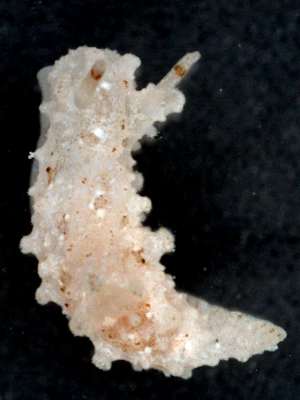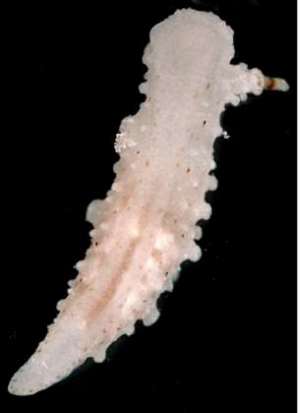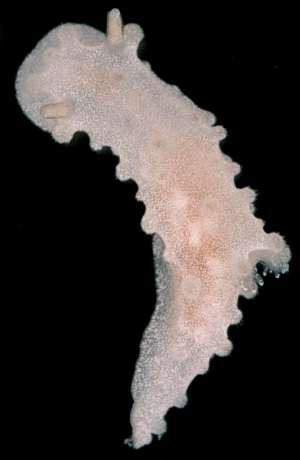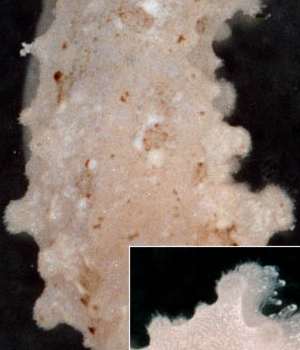
Aegires ortizi
Templado, Luque & Ortea, 1987
Order: NUDIBRANCHIA
Suborder: DORIDINA
Superfamily: ANADORIDOIDEA
Family: Aegiretidae
DISTRIBUTION
Caribbean region [known only from Cuba and the Bahamas]
PHOTO
Upper right: [darker specimen] 5.5mm. On Cladophora, intertidal on a seawall at Treasure Cay, Abaco, Bahamas. 18 June 1997. Lower left: Ventral view of darker specimen. Lower right: [light colour form]. 5mm. On attached Sargassum in 1m at Scotland Cay, Abaco, Bahamas. 29 June 1996. Photos: Colin Redfern.
This species is known only from the original description, based on a single specimen from Cuba, and Redfern's account (2001) of specimens from the Bahamas. Templado et al (1987) describe the colour as "creamy yellow with minute white punctae in the region of the tubercular rows ... dark brown spot on the top of each tubercle, and ... some oval rounded spots of this colour ... distributed over the dorsum" The tubercles are described as 'more or less conical '
Redfern's description, based on many specimens shows that this species is quite variable in colour, with some specimens with noticeable brown spots and others with no indication. Of particular interest is the variability in the shape of the tubercles. Templado et al described them as 'more or less conical' but Redfern's photos here show that the shape can range from conical to mushroom shaped, with a flattened top in a single individual. flattened quite heavily suggesting that the tubercles can change shape as described for other species of Aegires [message #14229 ]. In the paler animal spicules are visible projecting from the tip of some tubercles. In the original description a brown spot was described from the tip of each tubercle. A trace of this can be seen in the paler animal, but this is only apparent when the tubercles are in their conical phase.
-
Redfern, C. (2001) Bahamian Seashells: a Thousand Species from Abaco, Bahamas. BahamianSeashells.com, Inc., Boca Raton, Florida. 280 pages.
-
Templado, J., Luque, A. A., & Ortea, J. (1987) A new species of Aegires Loven, 1844 (Opisthobranchia; Doridacea; Aegiretidae) from the Caribbean Sea: Aegires ortizi spec. nov., with comparative descriptions of the North Atlantic species of this genus. The Veliger 29: 303-307.


Rudman, W.B., 2005 (July 12) Aegires ortizi Templado, Luque & Ortea, 1987. [In] Sea Slug Forum. Australian Museum, Sydney. Available from http://www.seaslugforum.net/find/aegiorti
Related messages
Aegires ortizi for the Forum
July 13, 2005
From: Colin Redfern

Dear Bill,
Here are a couple of examples of Aegires ortizi from Abaco, Bahamas to add to your recent treatment of this genus on the Forum.
This is not an uncommon species in Abaco, usually occurring on Cladophora but sometimes found on other algae. As mentioned in Bahamian Seashells, 23 specimens crawled out of a small sample of unattached (balled) Cladophora on one occasion.
One photo shows an example of the lighter color form, and on these animals there is sometimes only a hint of brown color on the rhinophores. Darker animals can have a ring of brown dots on each rhinophore or, as shown in the second photo, an almost solid ring of color. I've included a ventral view of this specimen.
Upper right: [darker specimen] 5.5mm. On Cladophora, intertidal on a seawall at Treasure Cay, Abaco, Bahamas. 18 June 1997. Lower left: Ventral view of darker specimen. Lower right: [light colour form]. 5mm. On attached Sargassum in 1m at Scotland Cay, Abaco, Bahamas. 29 June 1996.
-
Redfern, C. (2001) Bahamian Seashells: a Thousand Species from Abaco, Bahamas. BahamianSeashells.com, Inc., Boca Raton, Florida. 280 pages.
Best wishes,
Colin
bahamianseashells@att.net



Thanks Colin,
It's nice to be able to add another of these rarely photographed animals to the Forum. It also helps to define the species, which was based on a single specimen. Apart from showing colour variation your photos also show considerable variability in the shape of the tubercles. Templado et al described them as 'more or less conical' but your photos - see close-up alongside - show that the shape can range from conical to mushroom shaped, with a flattened top, in a single individual, suggesting that the tubercles can change shape as described for other species of Aegires [message #14229 ]. In the paler animal spicules are visible projecting from the tip of some tubercles.
Best wishes,
Bill Rudman
